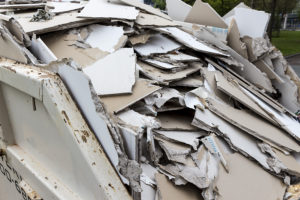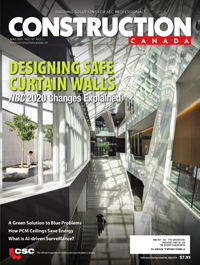Construction and silicosis: What you need to know

Assessing and controlling the risks
High dust levels are caused by one or more of the following:
- task—high-energy tools can produce a lot of dust in a very short period;
- time—the longer the work takes, the more dust there will be;
- frequency—regularly doing the same work day after day increases the risks of exposure; and
- work area—the more enclosed a space, the more the dust builds up (one should not assume dust levels will be low when working outside).
For specific activities where RCS could become airborne, separating the workers and the airborne materials can be a successful solution. In some cases, the means can be as simple as dousing the dust source with a water stream and standing upwind. Where possible, it is also important to specify materials that have less silica content or do not produce large volumes of dust.
Stopping or reducing the dust before work starts is also crucial for controlling the risks. This might mean different materials (e.g. the right size of building materials reduces cutting or preparation), less-powerful tools, or other work methods.
Regardless, the most important action is to stop the dust getting into the air, and more critically into the breathing zone of the workers. There are two main ways of doing this effectively: water and on-tool extraction.
Water damps down dust clouds, but to be effective, this needs to be in a fine mist or deluge form at a steady volume rate. Simply dampening material beforehand may not be as effective.
On-tool extraction removes dust as it is being produced. This type of local exhaust ventilation (LEV) fits directly onto the plant, tools, and equipment. The “system” consists of several individual parts—the tool, capturing hood, extraction unit, and tubing. It is important to use an extraction unit to the correct specification (i.e. H [high], M [medium], or L [low] class of filter unit). An industrial vacuum cleaner with a high-efficiency particulate air (HEPA) filter should be employed.
One size does not fit all: Thoughts on RPE

Image © Nayab Sultan
Before selecting respiratory protective equipment (RPE), there are various considerations ranging from the type to the duration of activities. Generally, it is far easier and more efficient to use engineering controls to protect a wider range of workers than ill-fitting RPE that may give a false sense of security and endanger the lives of wearers.
Refer to Canadian Standards Association (CSA) Z.94.4-11, Selection, Care and Use of Respirators, before selection of RPE, which must be adequate for the amount and type of dust; it should have an assigned protection factor (APF) showing how much protection it gives the wearer. The general level for RCS dust is an APF of 40 based on the activity—this means the wearer only breathes 1/40th of the amount of dust in the air.
The RPE must also be suitable for the job. Disposable masks or half-masks can become uncomfortable to wear for long periods, whereas powered air-supply RPE helps minimize this. When people are working for more than an hour, it is also important to consider whether the RPE is compatible with other items of protective equipment. Face-fit testing can ensure it is being worn correctly (ideally, anyone using tight-fitting masks will be clean-shaven), but RPE is the last line of protection.
The correct HEPA-type cartridge should be fitted to protect workers against silica dust exposure. In Canada, this tends to be magenta or purple, but one should always refer to the manufacturer’s safety data sheet or follow recommendations based on findings of air-monitoring. It should be remembered that on-tool extraction coupled with water dousing and suitable RPE provides significantly greater protection than RPE alone.
Reviewing the controls
Even with all the right controls in place, they must be checked to ensure they are working properly. This means:
- having procedures to ensure work is done in the right way;
- checking controls are effective (if the work still seems ‘dusty,’ exposure monitoring should be considered);
- involving workers, as they can help identify problems and find practical solutions;
- maintaining equipment (e.g. following manuals, inspecting for damage, making repairs, replacing masks, storing and maintaining non-disposable RPE, and testing on-tool extraction systems); and
- supervising workers to ensure they use the controls provided, follow the correct work method, and attend any health surveillance where required.
Air-monitoring
Personal or background air-monitoring should be carried out to accurately determine the levels of dust generation at various positions in the worksite. Monitoring will enable the correct selection of dust control methods and respiratory protection. Regular air-monitoring on existing and new work methods will help ensure in-place dust control methods remain effective and provide adequate protection for workers.
Health surveillance
A health surveillance program will be important to verify controls are protecting staff. The surveillance program should be under the direction of a suitably qualified medical professional and can include pre-employment health screening, occupational history and respiratory questionnaires to set baselines, coupled with suitable lung function testing and biological effect monitoring to monitor actual exposure levels. The frequency of testing should be determined by risk factors rather than a generic pre-determined testing period.
Protective clothing
It is vital dusty clothes do not contaminate cars, homes, or other areas outside of the worksite. Workers should have disposable overalls or washable clothes to change into at the site. Before leaving, workers should shower if possible and then change into clean clothes without shaking these out. Workers should not be taking dusty clothing home to wash—this may expose family to harmful levels of RCS dust. There are documented cases of family members getting sick from indirect exposures to silica dust and asbestos.
Training
Workers should be provided with competency-based training on silica dust awareness. This includes information about the health effects of exposure to silica dust, work practices to follow when silica dust is created at a worksite, and the appropriate use and care of protective equipment. It is vital to ensure workers actually understand rather than just sit through the talk.
Prevention is the best form of protection against silicosis and other illnesses, by either complete elimination of the silica dust hazard or introducing suitable dust-control strategies using dry air-filtering and water spray where dust emanates. That said, each worksite needs to have a comprehensive review of the hazards covering which technique is likely to be appropriate and establishing suitable and effective risk-control measures such as development of an exposure control plan (ECP)—required in most workplaces where high levels of dust are identified. Some provinces such as British Columbia have developed online tools for the construction sector.
Conclusion
Based on current medical knowledge, silicosis is not considered to be curable. (Therapy can alleviate some of the symptoms and provide some relief.) It can develop within a few weeks of heavy exposure and continue even years after exposure ceases. (Smoking can also exacerbate the symptoms.) In many cases, silicosis is considered asymptomatic—a person may not show classic signs of silicosis, which is one of the reasons why misdiagnosis is widespread. Prevention of exposure is the key.
 Nayab Sultan is a researcher at Silicosis Research, and is currently pursuing his PhD in silicosis prevalence in Canada. He holds M.Sc. and M.Phil. degrees in the science of occupational health, safety, and the environment. Sultan has more than 25 years of experience in construction and engineering, and has worked as a subject matter expert to several organizations, both in Canada and beyond. He can be reached at nmsultan@gmail.com.
Nayab Sultan is a researcher at Silicosis Research, and is currently pursuing his PhD in silicosis prevalence in Canada. He holds M.Sc. and M.Phil. degrees in the science of occupational health, safety, and the environment. Sultan has more than 25 years of experience in construction and engineering, and has worked as a subject matter expert to several organizations, both in Canada and beyond. He can be reached at nmsultan@gmail.com.







